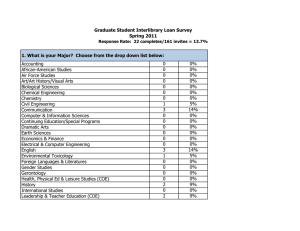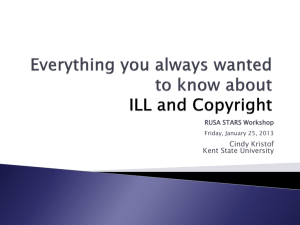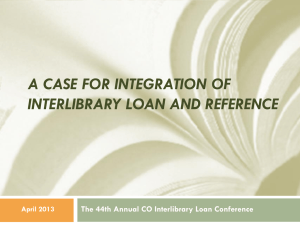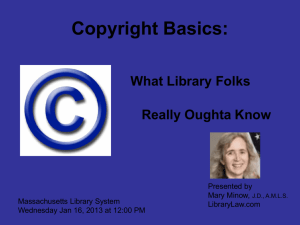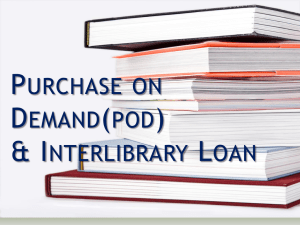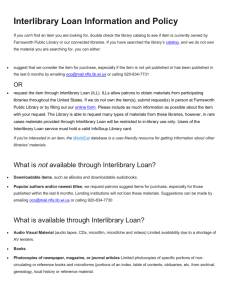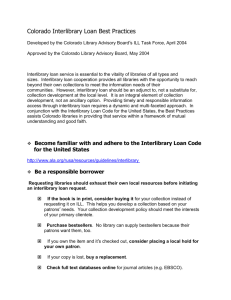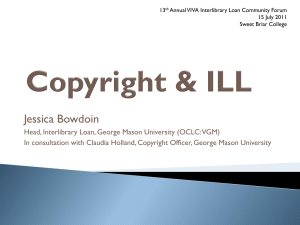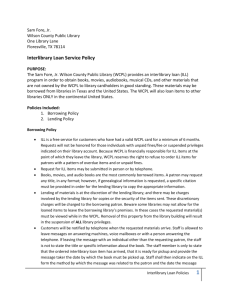Document
advertisement
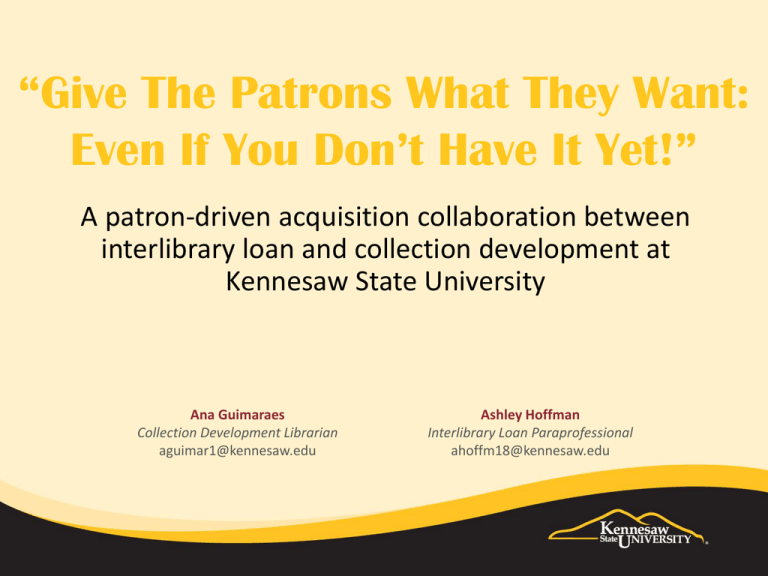
“Give The Patrons What They Want: Even If You Don’t Have It Yet!” A patron-driven acquisition collaboration between interlibrary loan and collection development at Kennesaw State University Ana Guimaraes Collection Development Librarian aguimar1@kennesaw.edu Ashley Hoffman Interlibrary Loan Paraprofessional ahoffm18@kennesaw.edu Why Now? Research The Plan Application Outcome PDA and ILL at Sturgis Library Why Now? Research The Plan Application Outcome What Next? What next? Why Now? Research The Plan Application Outcome What next? Why Now? • Good timing • eBook demand-driven acquisition (DDA) program already in development • Expanding interlibrary loan services: document delivery • campaign: transforming services and collection • Increased interest in collection development Why Now? Research The Plan Application Outcome What next? Research • Literature review to weigh PROS and CONS • Lack of cost-per-use data • Stakeholders: - Internal (CD, ILL, acquisitions, access services) vs. - External (patrons, vendors, consortia partners) Why Now? Research The Plan Application Outcome What next? Research “The ACRL (2010) listed PDA as a new force in collection development explaining: ‘academic library collection growth is driven by patron demand and will include new resource types’.” (Wiley, 2012, p.105) • Factors contributing to PDA: – Low circulation – Economic recession and budget cuts – Availability of new vendor products for online ordering Why Now? Research The Plan Application Outcome Research • Literature review to weigh PROS and CONS • Lack of cost-per-use data • Stakeholders: - Internal (CD, ILL, acquisitions, access services) vs. - External (patrons, vendors, consortia partners) What next? Why Now? Research The Plan Application Outcome What next? Research • ILL, Patrons, and Subject Liaisons: – Underrepresented subjects and departments – Tracking curriculum changes – New or developing program areas “ILL increases the connection between academic departments and the library, and can help identify areas where the library needs to improve while highlighting current users.” (Leykam, 2008, p.219) Why Now? Research The Plan Application Outcome What next? Research • Literature review to weigh PROS and CONS • Lack of cost-per-use data • Stakeholders: - Internal (CD, ILL, acquisitions, access services) vs. - External (patrons, vendors, consortia partners) Why Now? Research The Plan Application Outcome What next? The Plan • Hypothesis: To improve customer service and library collections • Our mission and goals • Dates: June-July 2013 • Parameter development and revision Why Now? Research The Plan Application Outcome What next? The Plan Scope Only books… …that we don’t have ……..that we have to pay to borrow ……………that are available for rush purchasing ……………….that cost less than our $200 price limit Why Now? Research The Plan Application Outcome The Plan Criteria Must meet 2 out of 3 of the following: Requested by special status patron Requested at least once before Has a cost of less than $50 What next? Why Now? Research The Plan Application Outcome Application Add to collection Check Criteria Place Order Finish Processing Patron Basic Returns Processing What next? Why Now? Research The Plan Application Outcome What next? Outcome • • • • Books to Be Purchased Total Cost Before Shipping Highest Cost to Borrow June 4 $100.85 $140.00 July 9 $264.70 $315.00 Low numbers led to revision of parameters Purchase cost less than highest cost to borrow Time-consuming process Problems encountered Why Now? Research The Plan Application Outcome Outcome 60 50 40 Others Considered Qualified but no Rush 30 Actually Purchased 20 10 0 June July Problems with Rush Availability What next? Why Now? Research The Plan Application Outcome What next? Outcome Foreign Language 26% General Academic 41% Key • • Popular 15% Rare 18% Types of Books Considered • “Popular” includes self-help, non-literary fiction, and popular non-fiction “Rare” are books that were too rare to be found in our vendor’s catalog “General Academic” was everything else Why Now? Research The Plan Application Outcome Outcome Collection Development Interlibrary Loan • ILL vs. collection development • Lessons learned What next? Why Now? Research The Plan Application Outcome What next? What Next? • • • • • Alternative vendors Funding source Borrow now, buy later Use ILL statistics to inform subject liaisons Revision of parameters to enhance collection development Credits Wiley, L. & Clarage, E. (2012). Building on success: evolving local and consortium purchase-on-demand programs. Interlending & Document Supply, 40(2), 105-110. Leykam, A. (2008). Exploring interlibrary loan usage patterns and liaison activities. Interlending & Document Supply, 36(4), 218-224. van Dyk, G. (2011). Interlibrary loan purchase-on-demand: a misleading literature. Library Collections, Acquisitions, & Technical Services, 35, 83-89. Special Thanks: Kiara Bynum, Interlibrary Loan Paraprofessional, Kennesaw State University Jay Nicolletta, Acquisitions Paraprofessional, Kennesaw State University Thank You! QUESTIONS?
